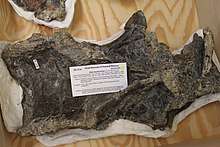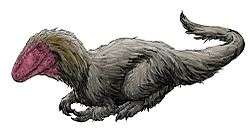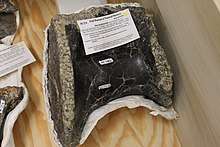Siats
| Siats | |
|---|---|
 | |
| Skeletal reconstruction of known elements | |
| Scientific classification | |
| Kingdom: | Animalia |
| Phylum: | Chordata |
| Clade: | Dinosauria |
| Order: | Saurischia |
| Suborder: | Theropoda |
| Family: | †Neovenatoridae |
| Genus: | †Siats Zanno & Makovicky, 2013 |
| Type species | |
| †Siats meekerorum Zanno & Makovicky, 2013 | |
Siats is an extinct genus of large neovenatorid theropod dinosaur known from the Late Cretaceous Cedar Mountain Formation of Utah, US. It contains a single species, Siats meekerorum. S. meekerorum could be the first neovenatorid discovered in North America and the geologically youngest allosauroid yet discovered from the continent.[1] It was initially classified as a megaraptoran, a clade of large theropods with very controversial relationships. This group may be examples of tyrannosauroids,[2] neovenatorid allosauroids,[1] or basal coelurosaurs.[3]
Discovery

Siats was first described and named by Lindsay E. Zanno and Peter J. Makovicky in 2013 and the type species is Siats meekerorum. The generic name is derived from the name of Siats, a man-eating monster in the Ute mythology.[1] The specific name meekerorum honours the late geologist John Caldwell Meeker who bequeathed a fund for the support of paleontological research, his widow Withrow Meeker and their daughter Lis Meeker, one of the volunteers in the research project.[1]
Siats is known from the holotype FMNH PR 2716, a partial postcranial skeleton housed at the Field Museum of Natural History, Chicago. FMNH PR 2716 consists of five dorsal and eight caudal vertebrae, a chevron, partial right ilium, ischium and fibula, a partial left tibia, and several right and left pedal phalanges.[1] FMNH PR 2716 was discovered by Lindsay Zanno, as a part of a 2008 expedition of the Field Museum led by Peter Makovicky.[4] It was collected between 2008 and 2010 from the Mussentuchit Member of the Cedar Mountain Formation, in Emery County of Utah, dating to the early Cenomanian stage of the Late Cretaceous, approximately 98.5 million years ago.
Description

The holotype came from a single immature individual, based on the incomplete fusion of neural arches to their centra in the vertebral column. Siats is characterized by seven diagnostic, including four autapomorphic (i.e. unique), traits. Its autapomorphies include the subtriangular cross section of the distal caudal vertebrae, elongated centrodiapophyseal laminae lacking noticeable infradiapophyseal fossae on the proximal caudals, a transversely concaved acetabular rim of iliac pubic peduncle, and the presence of a notch on the end of the truncated lateral brevis shelf. Other notable traits include the broad neural spines on the dorsal vertebrae.[1]

Siats represents one of the largest known theropods from North America. Zanno and Mackovicky (2013) estimated the femur length of the holotype to be in the range of 1166 and 1410 mm plotting the dyaphiseal measurements of the fibula in a regression relating those measurements to femoral length in other theropod taxa. Then used the length obtained in an allometry regression based on femoral length that got a mass of 3917 kg. It was mentioned that the holotype individual was not mature on the basis of the unfused neural arches of the dorsal vertebrae, suggesting a skeletally immature individual that had yet to grow.[1]
If it is a neovenatorid, the discovery of Siats also reveals that allosauroids did not yield dominance in North America to tyrannosauroids until the late Cretaceous.[5] However, there has been and still is substantial disagreement on the classification of megaraptorans, which are usually found to be either neovenatorids or tyrannosauroids, often with both interpretations appearing in the same paper.[3] Siats' placement within megaraptora has also been a source of controversy, with most recent analyses placing it as a non-megaraptoran neovenatorid regardless of the placement of megaraptora.[6]
Phylogeny and classification
Siats was initially classified as a megaraptoran neovenatorid closely related to Chilantaisaurus upon its discovery in 2013, based on the presence of pronounced centrodiapophyseal laminae bracketed by deep infradiapophyseal fossa on the caudal neural arches, similar to that of the Megaraptoran Aerosteon. A 2014 description of a juvenile Megaraptor reanalyzed the referral of Siats to megaraptora and found that the referral was likely mistaken and that megaraptorans were tyrannosauroids rather than neovenatorids such as Siats. The paper noted that, although sharing various features with Neovenator, Siats was very different from megaraptorans in the structure of its dorsal vertebrae, ilium, and fibula.[6] Subsequent studies, even those providing analyses where megaraptorans are placed as neovenatorids, still place Siats and Chilantaisaurus as neovenatorids outside of megaraptora.[7]


The cladogram presented below (created prior to these more recent studies) follows Zanno & Makovicky (2013).[1]
| Allosauroidea |
| |||||||||||||||||||||||||||||||||||||||||||||||||||||||||||||||||||||||||||||||||||||||||||||||||||||||||||||||||||||||||||||||||||||||||||||
| Wikispecies has information related to siats |
| Wikimedia Commons has media related to Siats. |
References
- 1 2 3 4 5 6 7 8 Zanno, L. E.; Makovicky, P. J. (2013). "Neovenatorid theropods are apex predators in the Late Cretaceous of North America". Nature Communications. 4: 2827. Bibcode:2013NatCo...4E2827Z. doi:10.1038/ncomms3827. PMID 24264527.
- ↑ F. E. Novas; F. L. Agnolín; M. D. Ezcurra; J. I. Canale; J. D. Porfiri (2012). "Megaraptorans as members of an unexpected evolutionary radiation of tyrant-reptiles in Gondwana". Ameghiniana. 49 (Suppl.): R33.
- 1 2 "Archived copy" (PDF). Archived from the original (PDF) on 2016-08-18. Retrieved 2016-07-24.
- ↑ Johnson, Steve (22 November 2013). "New dinosaur discovered by Field Museum expedition". Chicago Tribune. Retrieved 22 November 2013.
- ↑ Jha, Ajit (22 November 2013). "'Man-Eating Monster' Dinosaur Was Top Predator Before T. Rex; Discovery Solves 30 Million Year-Old Puzzle". International Science Times. Retrieved 24 November 2013.
- 1 2 Porfiri, Juan D.; Novas, Fernando E.; Calvo, Jorge O.; Agnolín, Federico L.; Ezcurra, Martín D.; Cerda, Ignacio A. (2014-09-01). "Juvenile specimen of Megaraptor (Dinosauria, Theropoda) sheds light about tyrannosauroid radiation". Cretaceous Research. 51 (Supplement C): 35–55. doi:10.1016/j.cretres.2014.04.007.
- ↑ Coria, Rodolfo A.; Currie, Philip J. (2016-07-20). "A New Megaraptoran Dinosaur (Dinosauria, Theropoda, Megaraptoridae) from the Late Cretaceous of Patagonia". PLoS ONE. 11 (7). doi:10.1371/journal.pone.0157973. ISSN 1932-6203. PMC 4954680. PMID 27439002.
